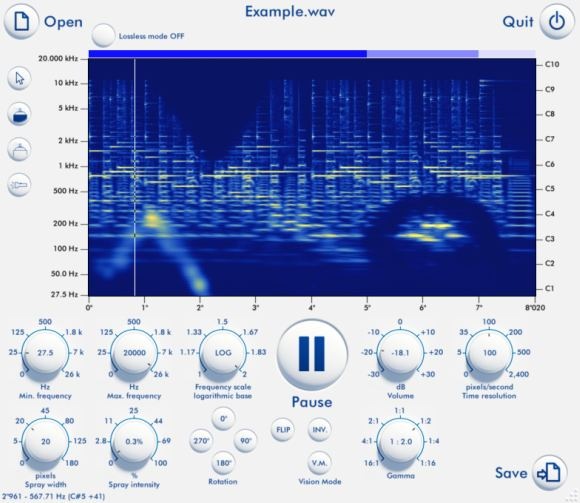Sound is a wonderful, if invisible thing. To work with these tiny fluctuations in air pressure that make up what we hear, we always work with some sort of software metaphor. So why not make that metaphor pixels – and why not manipulate the visual element directly?
Translating between sound and image is not a new concept in music software. The deepest tool for these functions is unquestionably the Mac-only classic MetaSynth, which sprang from the imagination of Bryce creator and graphic designer Eric Wenger. To me, one of the most appealing features of MetaSynth has always been its filter tool, the one component that allows you to work directly with sound using imagery and painting tools. The core of the tool, however, turns images into a score for synthesis, which opens up powerful features for microtones and the like but can conversely make simply designing sounds more challenging. (Side note: Leopard users, read this re: MetaSynth.)
Photosounder looks like MetaSynth, but it more directly translates between sound and image. It also has a uniquely straightforward interface for precisely adjusting controls and mappings. Put these together, and you can really use Photosounder as an audio tool. That opens up not only experimental techniques, but even makes conventional tasks more accessible.
Photosounder is also under very active development, with recent additions like a lossless mode for better sound fidelity and loop modes. The result is a really compelling looking tool for audio manipulation.
What can you do with these pixel powers over sound? Users have been experimenting and posting some pretty impressive stuff:
- Isolating and removing individual instruments – making this an ideal remixing and sampling tool – using Photoshop
- Making entire tracks from photographs (which, again, was possible with MetaSynth as infamously employed by Aphex Twin, but sounds very different here)
- Processing using Photoshop filters
- Making beats by drawing
- Extreme time processing
Photosounder is currently Windows-only, but Linux and Mac versions are promised. (By the way, I think that’s going to become more commonplace as savvy developers take up cross-platform development tools, toolchains, and frameworks.)
It’s cheap enough to impulse-buy, too, at EUR25 non-commercial or EUR99 commercial.
Photosounder examples (with video)
I hope to get my hands on Photosounder and show off some features with this soon. Thanks to everyone who sent this in! (And yeah, after four or five people I finally get around to mentioning it!)
The best way to see what’s possible: check out the videos. Here’s a selection of my favorites:
